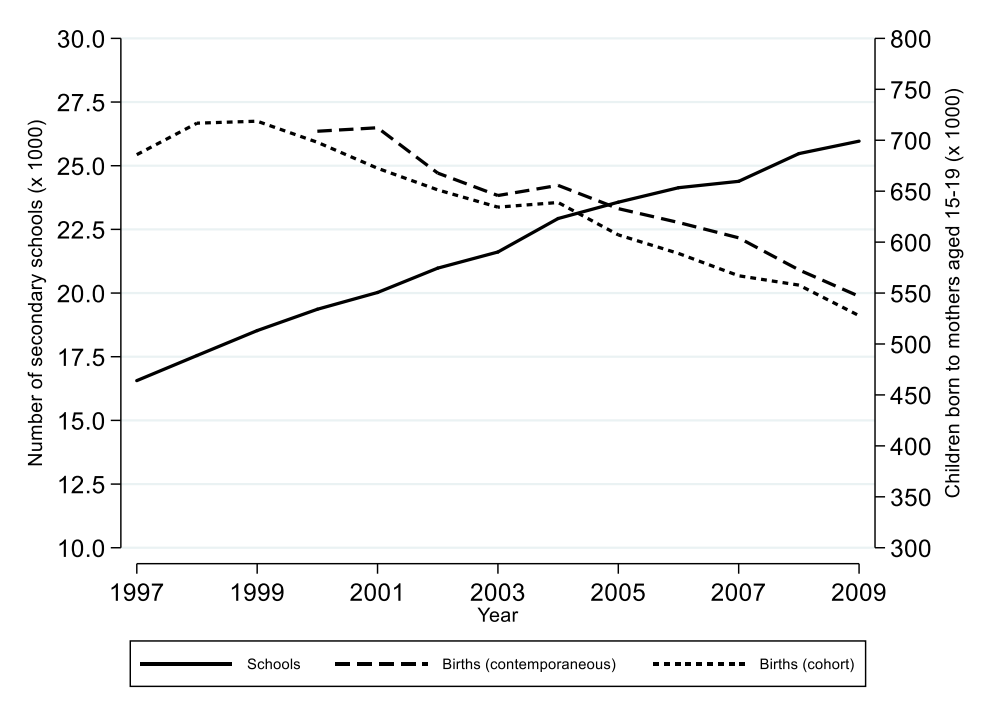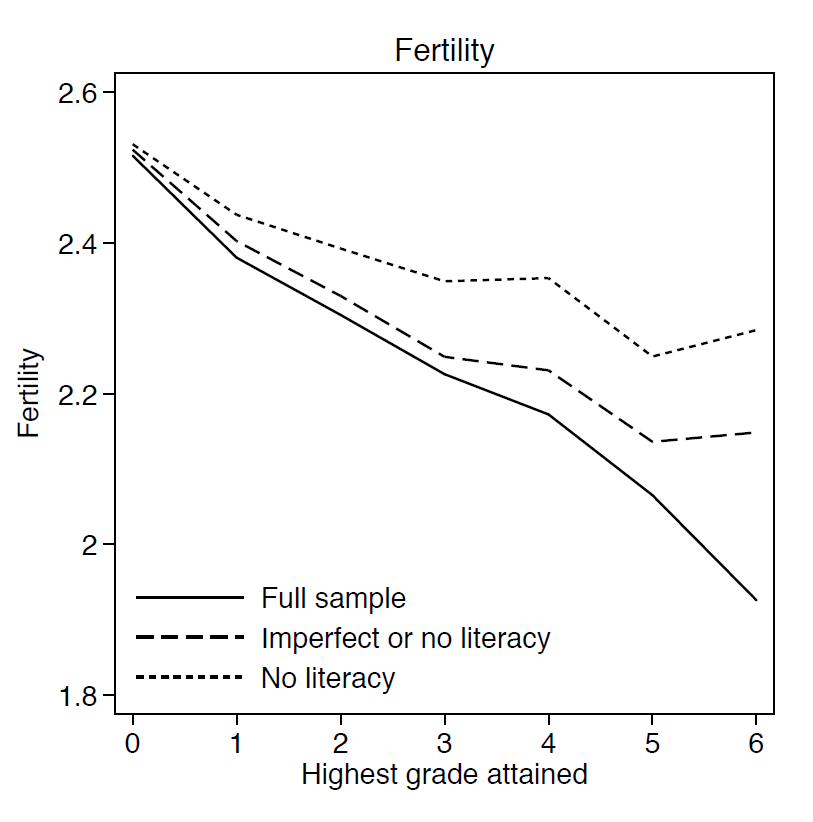-
Want to reduce teen pregnancy? Build high schools. Over the course of 12 years, Brazil built more than 7,000 additional secondary schools. Over those same 12 years, the teen pregnancy rate fell by almost 20 percent. But wait! Correlation doesn’t imply causation, right? A new study by Koppensteiner and Matheson looks at the rollout of the new secondary schools, municipality by municipality, and how teen pregnancies fall with that expansion. “Our estimates suggest that approximately 34% of the total decline in teenage childbearing observed in Brazil since 1997 can be attributed to the expansion of secondary schools.” This reminds me of research by Oye, Pritchett, and Sandefur showing that even with poor learning outcomes, more schooling is associated with lower fertility and higher rates of child survival across a sample of 50+ low- and middle-income countries.
In Brazil, more secondary schools attributed to decline in teen pregnancy
Source: Koppensteiner and Matheson 2019
Across 50+ countries, more schooling—even low-quality schooling—was associated with lower fertility
Source: Oye, Pritchett, and Sandefur 2016
Now what if you’re thinking, “Hey, what’s the big deal with teen pregnancy?” I don’t know who’s thinking that but just in case, a new study from India—by Perez-Alvarez and Favara—shows that being born to a teen parent affects both children’s health and their cognitive ability.
-
Flip the classroom and maybe you’ll increase learning inequality. At West Point, the US military academy, researchers—Setren and others—randomly assigned students in math and economics classes to a traditional classroom or a “flipped classroom.” In short, a flipped classroom means that students have their first exposure to the content before class (whether through a video or through reading), and then class time is focused on assimilating the knowledge through problem-solving, debate, or other activities. (Remember all the reading you were supposed to do before your college classes?) On a unit quiz, students in the flipped classroom perform better in math, albeit not in economics. But here’s the clincher: “The flipped classroom has a 69 percent larger white - black or Hispanic achievement gap relative to the standard lecture and it exacerbates the difference between students who scored in the top and bottom ACT quartile by 23 percent.” (The ACT is a standardized test used in college admissions in the United States.) And even worse: “While, the average effects fade by the course final, the achievement gaps persist.”
Now, this isn’t the only study of flipped classrooms. A study published last year used random assignment to evaluate the flipped classroom in an econometrics course. (Most students step into an econometrics course and think their world has been flipped regardless, but that’s a separate point.) They found a reasonable improvement in test scores from the flipped classroom. There have been other studies, with mixed results. But the West Point study’s impacts on the achievement gap are notable. In lower-income environments, one could imagine that differential access to digital resources at home could reinforce achievement gaps if the flipped classroom included video lectures or online tools. As ed-tech guru Mike Trucano has said about education technology interventions more broadly, “A lot of these innovations… tend to help those who already have various advantages because those people are able to take advantage of them more quickly for a variety of reasons.”
One critique of the West Point study is that video lectures aren’t enough to truly flip the classroom. That may be the case, but we have to be careful if we advocate models that only work when implemented ideally. I remember the program that trained teachers in Costa Rican middle schools to use active learning pedagogy and actually reduced student test scores, potentially because teaches “went through the motions…but did not master the innovation in a way that allowed students to make the most from them.”
-
Nobody’s perfect, but parents can improve. A large-scale parent training program in Chile—called “Nadie es perfecto” (Nobody’s perfect) and adapted from a Canadian program—had sizeable child development impacts, according to an evaluation by Carneiro and others. Parents participated in six to eight interactive group sessions over the course of a few months, learning about children’s physical and mental development, behavior management, safety, and parental self-care. Three years after the program had concluded, children of participating parents had better vocabularies and better social development. Those improvements were echoed in the quality of their home environments, with less harsh child discipline, more nurturing practices, and parents with clearer beliefs about their role in child development.
-
It’s easy to keep track of what every education system needs: Just remember UECPMBS! Michelle Kaffenberger thoughtfully reviews the evidence from the recent Research on Improving Systems of Education (RISE) conference and proposes that what every education system needs is “universal, early, conceptual and procedural mastery of basic skills” (hence UECPMBS and her admission that “yes, we need a better acronym”). In essence, every child needs the opportunity to learn (universal!), it’s really hard for kids who fall behind in early grades to catch up (early!), they have to learn concepts, not just memorize facts (conceptual!), they also have to learn procedures for solving math and reading problems (procedural!), they have to dominate the skills in order to be able to build on them (mastery!), and the crucial skills to do all this with are fundamental, building-block skills like literacy and numeracy (basic skills!).
Many education leaders that I speak with want to focus on secondary school or vocational education or universities. I get it: if you wait until your basic skills problems are completely resolved, you may never invest in other important aspects of education. But a failure to provide universal mastery of basic skills (plus the E and the C and the P) will forever limit what those other investments can accomplish.
-
Odds and ends. Nearly a year ago, the World Bank launched the Human Capital project. Patrinos and Angrist take stock of how the project and the underlying data that harmonizes learning outcomes across countries are being used. Atuhurra from Twaweza East Africa provides four recommendations for Uganda to improve the quality of its education system. Angel-Urdinola and Burgos-Dávila propose a way to use teacher assessments to design better teacher professional development systems, using Ecuador as a case study. Based on extensive interviews with education leaders in Pakistan and an examination of other evidence, Naviwala explores why Pakistan’s education outcomes have faltered despite big increases in spending.
Disclaimer
CGD blog posts reflect the views of the authors, drawing on prior research and experience in their areas of expertise. CGD is a nonpartisan, independent organization and does not take institutional positions.







